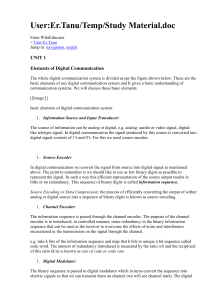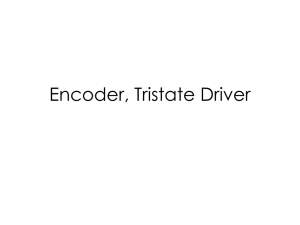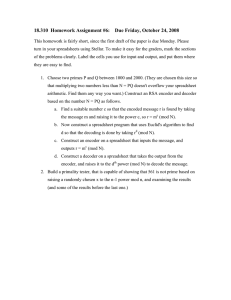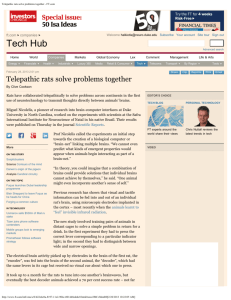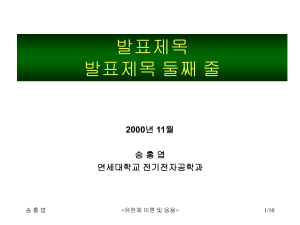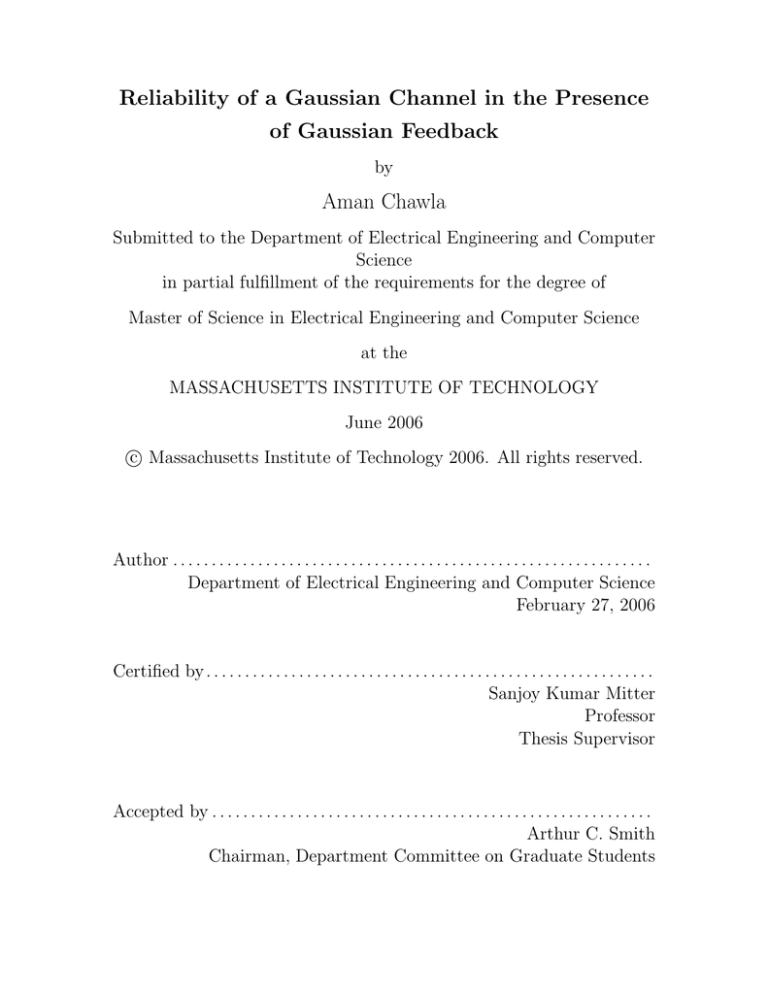
Reliability of a Gaussian Channel in the Presence
of Gaussian Feedback
by
Aman Chawla
Submitted to the Department of Electrical Engineering and Computer
Science
in partial fulfillment of the requirements for the degree of
Master of Science in Electrical Engineering and Computer Science
at the
MASSACHUSETTS INSTITUTE OF TECHNOLOGY
June 2006
c Massachusetts Institute of Technology 2006. All rights reserved.
Author . . . . . . . . . . . . . . . . . . . . . . . . . . . . . . . . . . . . . . . . . . . . . . . . . . . . . . . . . . . . . .
Department of Electrical Engineering and Computer Science
February 27, 2006
Certified by . . . . . . . . . . . . . . . . . . . . . . . . . . . . . . . . . . . . . . . . . . . . . . . . . . . . . . . . . .
Sanjoy Kumar Mitter
Professor
Thesis Supervisor
Accepted by . . . . . . . . . . . . . . . . . . . . . . . . . . . . . . . . . . . . . . . . . . . . . . . . . . . . . . . . .
Arthur C. Smith
Chairman, Department Committee on Graduate Students
Reliability of a Gaussian Channel in the Presence of
Gaussian Feedback
by
Aman Chawla
Submitted to the Department of Electrical Engineering and Computer Science
on February 27, 2006, in partial fulfillment of the
requirements for the degree of
Master of Science in Electrical Engineering and Computer Science
Abstract
The communication reliability, or error exponent, of a continuous time, infinite bandwidth, Additive White Gaussian Noise channel was studied under a peak power
constraint, in the presence of a feedback channel that was also a continuous time
peak-power constrained infinite bandwidth Additive White Gaussian Noise channel.
Motivated by [9], a two phase scheme was studied, where, in the first phase, the
Encoder transmits the message in small bit-packets and the Decoder then informs
the Encoder of the decoded message. With this knowledge, in the second phase, the
Encoder sends a confirm or deny signal to the Decoder and the Decoder then informs
the Encoder of its final action. In the first phase, the Encoder uses an orthogonal
signalling scheme and the Decoder uses a deterministic Identification code. In the
second phase, the Encoder uses antipodal signalling, while the Decoder utilizes a
sequential semi-orthogonal peak-power constrained anytime code. To improve the
reliability of the anytime code, additional messages are pipelined into the forward
channel by the Encoder once it finishes its phase two transmission, before receiving
the Decoder’s phase two transmission. Using this scheme, the following lower bound
on the reliability of this channel is obtained:
−1 1
R̄
1
1−
+
EGaussP eak (R̄) >
C2 4C1
C1
where R̄ is the average rate of data transmission and C1 and C2 are the capacities of
the forward and reverse channels respectively. To achieve this reliability, the capacity
of the reverse channel, C2 must be greater than the forward capacity C1 .
Thesis Supervisor: Sanjoy Kumar Mitter
Title: Professor
Acknowledgments
This thesis would not have been possible without the support and guidance of Prof.
Sanjoy Mitter and Prof. Anant Sahai, a former student of his. Prof. Mitter has
patiently waited for me, for nearly a year and a half, to find a problem of interest
and then supported and encouraged my foray into it. Prof. Sahai has been very
helpful, not only in formulating this problem in a precise fashion, but also providing
specific directions of investigation and many useful ideas, pointers, clarifications and
course-corrections.
Many lengthy discussions with fellow students Baris Nakiboglu and Lav Varshney, and post-doc Aslan Tchamkerten, and short discussions with faculty members
Prof. Alan Willsky and Prof. Robert Gallager helped me clarify my concepts and
understanding. The authors of all the textbooks and papers I have read are too many
to thank.
Credit for this work goes in no small measure to my parents, for their many
personal sacrifices for providing me a good education and thereby a secure future.
Their loving and patient support and care while I prepared for countless examinations
through the years is the silent and primary contributor to this affair. All the teachers
I have had, starting from kindergarten right up to those here, are the hidden authors
of this thesis. It is true that mine is the least contribution to this work.
Funding for this thesis was provided by the Army Research Office under the MURI
Grant: Data Fusion in Large Arrays of Microsensors DAAD19-00-1-0466 and the
National Science Foundation Grant CCR-0325774.
3
Contents
1 Introduction
6
2 Preliminaries
9
2.1
The Sahai-Simsek Transmission Scheme . . . . . . . . . . . . . . . . .
9
2.2
The Channel Model . . . . . . . . . . . . . . . . . . . . . . . . . . . .
10
3 The Code and Its Analysis
3.1
13
Phase 1 Transmission Analysis . . . . . . . . . . . . . . . . . . . . . .
13
3.1.1
Encoder Phase 1 . . . . . . . . . . . . . . . . . . . . . . . . .
13
3.1.2
Decoder Phase 1 . . . . . . . . . . . . . . . . . . . . . . . . .
14
Phase 2 Transmission Analysis . . . . . . . . . . . . . . . . . . . . . .
17
3.2.1
Encoder Phase 2 . . . . . . . . . . . . . . . . . . . . . . . . .
17
3.2.2
Decoder Phase 2 . . . . . . . . . . . . . . . . . . . . . . . . .
20
3.3
Total Error Probability . . . . . . . . . . . . . . . . . . . . . . . . . .
23
3.4
Expected Decoding Time . . . . . . . . . . . . . . . . . . . . . . . . .
24
3.5
The Reliability Function . . . . . . . . . . . . . . . . . . . . . . . . .
24
3.2
4 Conclusion
27
4
List of Figures
1-1 Additive Gaussian Memoryless version of communication setup in [9].
Here Z1 ∼ N 0, N21 and Z2 ∼ N 0, N22 . Z1 ⊥ Z2 . . . . . . . . . . .
8
2-1 Encoder’s transmission and reception timeline under the scheme in [9],
with W = 2 and
N
K
= 3. Note that ETx = DRx and ERx = DTx. . .
11
3-1 The Error Exponents of Scheme 1 (Eorth) and Scheme 2 (EdID). . .
18
3-2 A sequential semi-orthogonal peak-power constrained code, based on
the repeated PPM code in [7]. . . . . . . . . . . . . . . . . . . . . . .
22
3-3 Variable Delay Reliability Function of the Gaussian Channel with Gaussian Feedback . . . . . . . . . . . . . . . . . . . . . . . . . . . . . . .
5
26
Chapter 1
Introduction
In the field of information and communication theory, there has been much interest in the study of feedback and the role it can play in improving the reliability of
information transmission. The reliability function determines the speed of decay in
the error probability with block length or expected decoding time. It is nothing but
the exponent of the upper bound on the probability of error of the communication
scheme, divided by the expected decoding time.
We are primarily concerned with the reliability of information transmission over
continuous time Additive White Gaussian Noise (AWGN) channels, in the presence
of noisy (Gaussian) feedback (Figure 1). In the absence of any feedback whatsoever,
the reliability function of this channel has been known for long [12] to be exactly
given as follows
E(R) =
C/2 − R,
R ≤ C/4
√
√
( C − R)2 , C/4 ≤ R ≤ C
where C is the capacity of the channel and R is the rate of data transmission. This
reliability is achieved by using an orthogonal signalling scheme 1 .
With a peak power constraint and perfect noiseless feedback for the continuoustime additive Gaussian setting, Schalkwijk and Barron [10] demonstrate a significant
improvement in the achieveable error exponent over a no-feedback setting, by using a
1
However, doing list-decoding for orthogonal signaling on the ∞-bandwidth AWGN channel will
extend the “curvy” part of the curve in the same manner that it extends the curvy part for DMCs
[8].
6
two-phase sequential signalling scheme. They show that, for a peak-to-average power
ratio of α, the achiveable error exponent is
Eα (R) =
√
αC − R +
√
C −R
2
where C is the capacity of the forward channel and R is the rate of data transmission.
The scheme of Schalkwijk and Barron was slightly modified by Yamamoto and
Itoh in [13]. They avoid the use of Viterbi’s sequential decision feedback scheme [11]
in the second phase, but nevertheless achieve the following similar error exponent
ET (RT ) =
p
C − RT +
2
p
αC − RT
where RT is the effective transmission rate.
In the same paper, Yamamoto and Itoh also apply their modified scheme to the
case of a Discrete Memoryless Channel (DMC) with noiseless feedback and are able
to achieve the Burnashev error exponent
RN
EN (RN ) = C1 1 −
C
where C1 = max
′
k,k
J
P
j=1
Pjk ln
P
jk
′
Pjk
and [Pjk ] is the forward channel transition matrix.
The presence of noise in the feedback calls for some additional ideas, since it is at
first glance not clear whether noisy feedback would even be useful at all. It might just
increase the encoder’s confusion. An approach to the analysis of the noisy feedback
case is taken in [9] that looks at the situation where a stream of messages is to be
conveyed to the receiver. The authors extend the above-mentioned DMC scheme of
Yamamoto and Itoh [13] to the case where the feedback channel is also a DMC. Using
a combination of message pipelining and anytime coding, they are able to make use
of the feeback information and obtain the following lower bound on the reliability
function
7
Z1
Message
Queue
Message
Source
Encoder
Decoder
Z2
Figure 1-1: Additive
version of communication setup in [9].
Gaussian Memoryless
N2
N1
Here Z1 ∼ N 0, 2 and Z2 ∼ N 0, 2 . Z1 ⊥ Z2 .
Enoisy (R̄) ≈
1
1
+
C1 Eex (R)
−1 R̄
1−
C
(1.1)
where Eex (R) is the expurgated exponent at rate R.
Since a DMC, by definition [[4], §8.5], has finite sets for its input and output
alphabets, a natural next step is to see whether a similar analysis can be applied to
the situation where both the forward and feedback channels are Gaussian channels
with a peak power constraint. Specifically, in this thesis we will obtain the reliability
function of a communication setup where both the forward and feedback channels are
infinite-bandwidth continuous time peak power constrained Additive White Gaussian
Noise (AWGN) channels. Figure 1-1 provides a block diagram of the setup under
consideration.
The following is an outline of this thesis. In Chapter 2, we will present the preliminaries that will permit us to proceed with the detailed computation of the reliability
function. In Chapter 3 we will present this computation. Finally, in Chapter 4 we
will conclude with a summary of results and suggested directions for future research.
8
Chapter 2
Preliminaries
In this chapter, we will present the preliminaries that will permit us to proceed with
the detailed analysis in Chapter 3. We will begin with a brief study of a variabledelay communication scheme in the context of Discrete Memoryless Channels. This
scheme will be the framework in which we will study variable-delay communication
in the Gaussian setting. Following this brief study, we will present the details of the
point-to-point Gaussian channel that forms both the forward as well as the feedback
links of the communication setup under consideration.
2.1
The Sahai-Simsek Transmission Scheme
In this section we will provide a brief overview of the scheme used in [9] for transmitting messages taken from a queue over a DMC, in the presence of a feedback DMC.
The scheme consists of two phases. In Phase 1, a message block is transmitted and
then the decoder feeds back the message block it decoded to the encoder. In Phase
2, the encoder looks at this feedback and sends the decoder a confirm/deny signal,
directing it to either accept or reject that decoded message block. The encoder then
waits for state information from the decoder, which tells the encoder what the decoder finally did with that message block (i.e. did it keep it or discard it). During
this waiting period, the encoder continues to transmit, or pipeline, a few (say, W )
additional message blocks in the same two phase format. At the end of the waiting
9
period, the encoder possesses the state information and so can decide which message
block to transmit next - either a retransmission of the message block or a new message
from the message queue (see Figure 1-1).
Figure 2-1 provides an illustration of this scheme in action. The figure also indicates an additional feature of the scheme - before transmission, each message block
is broken into sub-blocks of length K each. As each sub-block is received, it can be
instantly decoded and the decoded sub-block can be immediately sent back along the
feedback link. This allows a significant reduction (from N time units to K time units)
in the amount of time the encoder has to wait in order to receive the entire decoded
block from the decoder.
To obtain the reliability result (1.1), in Phase 1 the encoder uses a random code
for transmission and the decoder uses an expurgated code. In Phase 2, the encoder
uses a repetition code and the decoder uses an anytime code.
Having provided an outline of the Sahai-Simsek scheme, we can now turn to the
Gaussian channel setting of Figure 1-1.
2.2
The Channel Model
The Gaussian channel under consideration is the infinite bandwidth continuous time
Additive White Gaussian Noise channel. This channel can be specified by the following equation
Y (t) = X(t) + Z(t)
where X(t) is the input signal, Z(t) is a white noise signal having one-sided power
spectral density N0 and Y (t) is the output signal. The input signal must have average
power P . There is no restriction on the bandwidth used by the input signal.
To use this channel for communication, we must specify the signalling scheme.
The signal set consists of M signals of duration T each: {s1 (t), · · · , sM (t)}. The
signals satisfy
ZT
s2i (t)dt = P T
0
10
Transmit
Confirm/De
ny 1
Transmit
Message 1
in 3 subblocks
Transmit
Message 2
in 3 subblocks
Retransmit
Message 1
or transmit
Message 4
in 3 subblocks
Transmit
Confirm/De
ny 2
Transmit
Confirm/De
ny 4
Block Accept/Discard
times at Decoder
ETx
N=3K
Receive
feedback for
all 3 subblocks of
Message 1
K
L
D = 2 (N+K+L)
Receive state feedback
regarding
Confirm/Deny 1
Decoder’s state vector xn gets appended by a 1 if
Confirm is received by the decoder and 0 otherwise.
Wait as though still receiving C/D 1 feedback
ERx
PHASE 1
Receive
feedback for
all 3 subblocks of
Message 2
PHASE 2
Receive state feedback regarding
Confirm/Deny 2
Wait as though still receiving C/D 2 feedback
ERx
Figure 2-1: Encoder’s transmission and reception timeline under the scheme in [9],
N
with W = 2 and K
= 3. Note that ETx = DRx and ERx = DTx.
11
in order to meet the average power constraint. Thus, by transmitting one of these
M signals, one communicates log2 (M) bits of information to the receiver. The rate
log2 (M )
T
R of data transmission is thus
bits per second. The maximum such rate at
which data can be transmitted with an arbitrarily small probability of error, i.e. the
P
.
N0
capacity of this channel is C =
For this channel, [12] shows that the reliability function is given exactly as
E(R) =
C/2 − R,
R ≤ C/4
√
√
( C − R)2 , C/4 ≤ R ≤ C
(2.1)
and this reliability is achieved by an orthogonal signal set, i.e.
ZT
si (t)sj (t)dt = P T δij
0
for i, j ∈ {1, · · · , M}. These orthogonal signals can be designed such that their peak
power is the same as their average power. This is the tightest possible peak power
constraint (since the ratio of peak to average power is 1).
This completes our description of the channel. In the remainder of the thesis,
the forward channel will have capacity C1 =
capacity C2 =
P2
.
N2
12
P1
N1
and the feedback channel will have
Chapter 3
The Code and Its Analysis
In this chapter we will present the details of the transmission scheme, and undertake
a computation of the variable-delay reliability function.
A message source produces one among M equiprobable outcomes at regular intervals of time. Each M-ary message enters into a message queue as illustrated in
Figure 1-1. It is the job of the Encoder to transmit these messages to the Decoder
over the channel in a reliable fashion.
3.1
Phase 1 Transmission Analysis
The transmission cycle begins with transmissions originating at the Encoder, over the
forward channel. We will first look at the Encoder’s phase 1 transmission.
3.1.1
Encoder Phase 1
The message m, representing log2 (M) bits of information arrives at the Encoder
from the queue. This message is broken into K packets, each containing
log2 (M )
K
bits
of information. The Encoder transmits one packet at a time using the orthogonal
signalling scheme discussed in section 3. Clearly, the number of messages required
1
in the signal set for transmitting a packet is M K . Each continuous time signal in
the signal set is of duration
T1
K
seconds, and has peak power the same as the average
13
power P1 . The rate of data transmission is
log2 (M) K
K
T1
log2 (M)
bits per second.
=
T1
(3.1)
R =
As each packet arrives at the Decoder, it performs Maximum Likelihood (ML)
decoding on that packet. From [[6], §8.2], this yields the following probability of
error.
Pe(1) , Pr(packet is incorrectly decoded) = f (R,
T1 − T1 Eorth(R)
)e K
K
(3.2)
where Eorth (R) is given by (2.1) by replacing C with C1 .
In K such transmissions, requiring total time T1 , the entire message m is transmitted by the Encoder. Assuming, for simplicity, that the transmissions started at
time 0, at time T1 the Decoder has thus received and decoded a total of log2 (M) bits.
Using the Union bound,
′
Pe(2) , Pr(overall decoded message m 6= m)
K
[
Pr(packet i decoded incorrectly)
=
≤
=
i=1
K
X
(3.3)
Pr(packet i decoded incorrectly)
i=1
K
X
Pe(1)
i=1
= KPe(1)
3.1.2
Decoder Phase 1
As each packet arrives at the Decoder, it decodes it immediately (using ML decoding
′
as discussed above in §4.1.1). Let us suppose that ML decoding yields message m = p
1
where p ∈ {1, . . . , M K }. Denote the actual message sent by the Encoder as m = l.
14
For the Encoder to be able to proceed with Phase 2, it needs to know whether or not
p = l. We can consider two alternative schemes for communicating this information
from the Decoder to the Encoder.
In the first scheme, the Decoder transmits the decoded packet back to the Encoder using essentially the same orthogonal signalling scheme that we discussed in the
1
previous section. The signal set consists of M K orthogonal continuous time signals,
each of duration
T3
,
K
with peak power the same as their average power P2 . The rate
of data transmission is R =
log2 (M )
T3
bits per second.
As each such packet arrives at the Encoder, it performs ML decoding. This yields
the following probability of error.
Pe(3) , Pr(packet is incorrectly decoded) = f (R,
T3 − T3 Eorth(R)
)e K
K
(3.4)
where Eorth (R) is given by (2.1) by replacing C with C2 .
The probability that the Encoder thinks the Decoder received the correct message,
′′
′
i.e. m = m when in fact it didn’t, i.e. m 6= m is upper bounded by the probability
that an error is made by the Encoder in decoding the feedback sent by the Decoder.
′′
′
Pe(4) , Pr(m = m 6= m )
′′
(3.5)
′
≤ Pr(m 6= m )
K
[
=
Pr(packet i decoded incorrectly)
≤
=
i=1
K
X
Pr(packet i decoded incorrectly)
i=1
K
X
Pe(3)
i=1
= KPe(3)
where the second inequality follows from the Union Bound. The first inequality can
be tightened with further analysis.
15
In the second scheme, we exploit the fact that all the Encoder is interested in, is
′
whether or not m = l. Beyond this, it is not interested in knowing exactly what the
′
value of m is. Thus we have here a standard Identification (ID) problem, which was
first introduced in [1] for Discrete Memoryless Channels. In [3] Burnashev considers
the case of the infinte bandwidth Additive White Gaussian Noise Channel. Using
essentially the same orthogonal signalling scheme that we discussed in the previous
section, he constructs a deterministic ID (dID) code and computes the probabilities of
missed detection and false alarm. The signal set consists of M orthogonal continuous
time signals Si (t), each of duration
T3
,
K
with peak power the same as their average
power P2 . The rate of the dID code is RdID =
K ln ln M
T3
[3].
Having received and decoded all the K packets from the Encoder, the Decoder
transmits signal Sj (t) if the overall decoded message received by it is j where j ∈
{1, . . . , M}. We fix a real number z > 0 and define the decision region Dl (z) as
follows:
T3
Dl (z) , {Y (t) :
ZK
Y (t)Sl (t)dt ≥ z}
0
If the received signal Y (t) falls in the decision region Dl (z), where l is the message
the Encoder wishes to identify, then the Encoder prepares to send a Confirm in Phase
2. If the received signal does not fall in the decision region Dl (z), then the Encoder
prepares to send a Deny in Phase 2. The probability of a False Alarm, i.e., the
received signal falls in Dl (z) when the Decoder actually sent Sj (t), j 6= l, is calculated
to be
(1)
Pf a , Pr(Y (t) ∈ Dl (z)|Sj (t) sent, j 6= l) = Φ q
−z
N2 P2 T3
2K
(3.6)
The probability of a Missed Detection, i.e., the received signal falls in Dj (z), j 6= l
when the Decoder actually sent Sl (t), is calculated to be
z − P2
(1)
Pmd , Pr(Y (t) ∈ Dj (z), j 6= l|Sl (t) sent) = Φ q
16
T3
K
N2 P2 T3
2K
(3.7)
(1)
′′
′
In this second scheme, Pf a plays the role of Pr(m = m 6= m ). We therefore wish
to make it as small as possible. However, we have a constraint that the probability
(1)
(1)
of missed detection, Pmd be less than 10−5 . Setting Pmd = 10−5, and using (3.7) we
q
x2
T3
N2 T3
can compute z = P2 K − 4 P22K
and thereby, from (3.6), and using Φ(x) ≤ e− 2 ,
we obtain
(1)
Pf a
≤e e
−8 −(C2
q
T3
+4
K
2P2 T3
)
N2 K
(3.8)
which, on dropping sublinear terms, yields the exponent
EdID = C2
(3.9)
independent of the size of the message set M, and hence independent of the rate of
the dID code. By comparison, from (3.4) and (3.5), the reliability function of the
first scheme is Eorth (R), given by (2.1) by replacing C with C2 . The two reliability
functions are illustrated in Figure 3-1.
It is clear from Figure 3-1 that regardless of the rate, the second scheme is to be
preferred over the first. Note that the second scheme also saves the Decoder much
transmission energy on the feedback - it need transmit only once where it would have
done so K times in the first scheme.
3.2
Phase 2 Transmission Analysis
We can now analyse the second phase of transmission. We will first look at the
Encoder transmission, which begins at time T1 +
3.2.1
T3
.
K
Encoder Phase 2
Using its decision regarding whether or not the Decoder obtained the right message in
Phase 1, the Encoder does the following. In case the right message was received, the
Encoder sends a Confirm signal which indicates to the Decoder that it ought to keep
the just-decoded block. Otherwise, the Encoder sends a Deny signal which indicates
17
Eorth
EdID
Exponent
C_2
C_2 / 2
0
0
C_2 / 2
Rate (R) bits per second
Figure 3-1: The Error Exponents of Scheme 1 (Eorth) and Scheme 2 (EdID).
18
C_2
to the Decoder that it ought to discard the just-decoded block. The Encoder uses a
pair of antipodal signals {r(t), −r(t)}, the former to indicate a confirm and the latter
a deny. Each signal is of duration T2 , with peak power the same as the average power
P1 .
Let the received signal be Y (t). We fix a real number z > 0 and decode to a
Confirm if
ZT2
Y (t)r(t)dt ≥ z
(3.10)
Y (t)r(t)dt < z.
(3.11)
0
and to a Deny if
ZT2
0
We then compute the probabilities of Missed Detection and False Alarm as follows.
(2)
Pmd = Pr(Decode to Deny | Confirm sent)
Z T2
= Pr(
Y (t)r(t)dt < z|r(t) sent)
0
Z T2
z − P1 T2
= Pr(
Z(t)dt < √
)
P1
0
z − P1 T2
= Φq
(3.12)
P1 N1 T2
2
(2)
Pf a
= Pr(Decode to Confirm | Deny sent)
Z T2
= Pr(
Y (t)r(t)dt ≥ z| − r(t) sent)
0
Z T2
−(z + P1 T2 )
√
)
= Pr(−
Z(t)dt ≤
P1
0
−(z + P1 T2 )
= Φ q
(3.13)
P1 N1 T2
2
(2)
If we set z = 0, we obtain Pf a ≤ e−C1 T2 . Thus the exponent is C1 , independent
19
of the rate. On the other hand, we can fix the probability of missed detection to be
some value, say 10−5 , and then determine the value of z as follows
z − P1 T2
(2)
Pmd = Φ q
P1 N1 T2
2
(3.14)
= 10−5
z − P1 T2
⇒ q
= −4
P1 N1 T2
2
⇒ z = P1 T2 − 4
r
P1 N1 T2
2
Thus, from (3.13), we obtain
√ √
2 C1 T2 )
(2)
Pf a ≤ e−8 e−(4C1 T2 −8
(3.15)
which, on dropping sublinear terms, yields the exponent 4C1 T2 .
3.2.2
Decoder Phase 2
Once the Decoder has decoded the phase 2 encoder signal, it performs the corresponding operation, i.e. it either discards or accepts the just-decoded block. What action
it performs constitutes 1 bit of information about its state. This information must be
conveyed back to the Encoder. Using this information the Encoder will decide which
message to transmit next. Thus it is quite important for the Decoder to communicate
the state information bit sequence in a reliable fashion.
We can do so by using an anytime code for this purpose. In [7], the author presents
a sequential semi-orthogonal anytime code for the infinite bandwidth AWGN channel.
It is a repeated pulse position modulation (PPM) scheme. However, the analysis in
[7] is not unique to PPM. The same analysis goes through even with a signal set
that meets the constraint that the peak power be the same as the average power
P2 . Specifically, the signal set consists of square waves gi (t), each of duration T4
20
seconds, arranged on a tree-structure (growing from left to right), with i being an
index to the branch of the tree that the signal gi (t) occupies. The index can be,
for example, a simple binary sequence that allows one to navigate to that signal,
with 0 being appended when you move “up”, and 1 when you move “down”. If we
consider all the signals at any particular “level” of the tree, the number of their zero
crossings increases by powers of 2 as one goes down that level. The amplitude of each
√
square wave is of course P2 . This tree structure, illustrated in Figure 3-2, gives the
code the important characteristic that every T4 seconds, not only is an additional bit
communicated, but also all previous bits are repeated.
At time T1 +
T3
K
+ T2 + T4 the Encoder receives the first state information signal,
say, g0 (t). It doesn’t immediately decode this signal. Instead, in order to increase the
reliability of the decoding, the Encoder operates at a fixed delay W , i.e. it waits for a
sequence of W signals to arrive before it decodes the first bit from the sequence. As
shown in [7], this allows the Encoder to operate with an error probability given by
Pe(5) , Pr(Received Decoder state information,
(3.16)
from bit 1 upto the bit received via the signal
that arrived W signals ago, is incorrect)
′
′′
≤ K e−W Eorth(R
′′
where R =
1
T4
)T4
′
bits per second is the rate of the anytime code, K > 0 is a constant,
and Eorth (R) is given by (2.1) by replacing C with C2 . Equation (3.16) thus gives
the probability that the Encoder selects the wrong message to transmit. Note that
during the delay period D = W (T1 +
T3
K
+ T2 ) the Encoder transmits an additional
W messages from the message queue.
21
2T4
2T4
T4
0
T4
T4
2T4
0
T4
T4
2T4
T4
Figure 3-2: A sequential semi-orthogonal peak-power constrained code, based on the
repeated PPM code in [7].
22
3.3
Total Error Probability
Having obtained the error probabilities of the individual phases of the scheme, we
are now in a position to compute the total probability of unrecoverable errors of the
scheme. An overall uncorrectable error occurs if one of the following occur [9].
1. The Encoder sends a Deny but it is decoded as a Confirm. This occurs with an
exponent 4C1 T2 , from (3.15).
2. The Encoder sends a Confirm when it ought to have sent a Deny. This occurs
with an exponent C2 TK3 , from (3.8).
3. The Encoder selects the wrong message to transmit. This occurs with an expo′′
nent W Eorth (R )T4 , from (3.16).
We can choose parameters such that all the above exponents are identical. Equating the first two exponents, we obtain
K=
C2 T3
4C1 T2
(3.17)
Since K is the number of bit packets that each message is broken into, we must have
K > 1. This yields the requirement that
C2 >
C1 4T2
.
T3
(3.18)
Equating the first and third exponents, we obtain
W =
4C1 T2
Eorth (R′′ )T4
(3.19)
which is always non-negative, since Eorth ( T14 ) is non-negative.
Thus, the total (uncorrectable) error probability has the exponent
− ln Pe = 4C1 T2 + sublinear terms.
23
(3.20)
3.4
Expected Decoding Time
We wish to obtain the expected time that it takes for a message to be sent from the
Encoder to the Decoder. Let us consider the cases in which a retransmssion of a
message is required [9].
1. Any packet of the Phase 1 Encoder transmission is received incorrectly. This
has probability given by (3.3). This probability can be made arbitrarily small
by increasing T1 .
2. A Confirm sent by the Encoder is decoded as a Deny. This is a constant, 10−5 ,
given by (3.14).
(2)
Thus the probability that a message will be retransmitted is ≤ Pe
+ 10−5 . Thus
(2)
a transmitted message is accepted with probability ≥ 1 − Pe − 10−5 . The possible
message acceptance times are {(T1 + TK3 +T2 ), (W +1)(T1 + TK3 +T2 ), 2(W +1)(T1 + TK3 +
T2 ), · · · }. Thus, the expected duration for a message to be successfully transmitted,
τ̄ , is upper bounded by
!
(2)
T3
Pe + 10−5
(W + 1)
(T1 +
+ T2 ) 1 +
(2)
K
1 − Pe − 10−5
(3.21)
T3
+ T2 )
K
4C1
= T1 + T2 1 +
C2
≅ (T1 +
(2)
where the second line holds because 10−5 is negligible and Pe can be made arbitrarily
small. The third line follows from (3.17).
3.5
The Reliability Function
We are now in a position to derive a lower bound on the reliability function EGaussP eak (R̄)
of the transmission scheme. Here R̄ =
log2 (M )
τ̄
transmitted by the scheme.
24
is the average number of bits per second
Using (3.1) and (3.20), (3.21) becomes
log2 (M) ln Pe
−
τ̄ <
R
4C1
C1
1+4
C2
(3.22)
where R is the nominal rate of data transmission by the Encoder in Phase 1.
Thus,
log2 (M) − ln Pe
C1
1 <
1+4
+
τ̄ R
τ̄ 4C1
C2
R̄
1
1
=
+ EGaussP eak (R̄)
+
R
C2 4C1
(3.23)
Thus,
EGaussP eak (R̄) >
1
1
+
C2 4C1
−1 R̄
1−
R
(3.24)
In order to maximize the lower bound, we must maximize R. Thus the optimal value
of T1 is
log2 (M )
C1
seconds. Thus, the lower bound now becomes
EGaussP eak (R̄) >
1
1
+
C2 4C1
This lower bound is plotted in Figure 3-3.
25
−1 R̄
1−
C1
(3.25)
EGaussPeak
((1/C2)+(1/4C1))-1
0
0
C_1
Average rate in bits per second
Figure 3-3: Variable Delay Reliability Function of the Gaussian Channel with Gaussian Feedback
26
Chapter 4
Conclusion
In this thesis, we computed the variable-delay reliability function of an infinitebandwidth peak power constrained continuous time Additive White Gaussian Noise
channel in the presence of a similar feedback channel. The main ingredients of the
communication scheme used were, an orthogonal signalling scheme to transmit the
message, a deterministic Identification code to obtain feedback, antipodal signalling
to confirm or deny the last message, and finally, a sequential code to transmit decoder
state information back to the encoder. In combination with message pipelining, this
scheme yielded a lower bound on the reliability function
EGaussP eak (R̄) >
1
1
+
C2 4C1
−1 R̄
1−
C1
This reliability was achievable under the condition that the capacity of the feeback
channel be greater than that of the forward channel [cf. (3.18)].
Our approach to this problem was motivated by the scheme of Sahai and Simsek
[9] which considered an identical situation, but for Discrete Memoryless Channels.
They computed the reliability for variable-delay decoding on DMCs with noisy feedback and were able to show that as the quality of the feedback link improves, i.e. as
the feedback gets less noisy, the reliability function approaches the Burnashev exponent. The Burnashev exponent is the highest possible variable delay error exponent
achievable when a DMC is used with noiseless feedback [2]. In a recent paper [5], as
27
yet unpublished, the authors look at a similar forward and feedback DMC scenario,
where the rate of communication on the forward link is greater than the capacity of
the feedback link. They work with a slight modification of the scheme in [9]. Instead of the Decoder transmitting the decoded message back to the Encoder using
an expurgated code, or utilizing an Identification code as in this thesis, the Decoder
transmits a random hash of the decision that it makes. A hash is simply a “blurred”
version of the decision - several message values are mapped to a single bin. Thus, for
′
example, if m = 9, a random partition of the set {1, 2, . . . , M} is made and the index
of the partition in which 9 falls is sent to the Encoder. Using this modified scheme,
the authors are able to obtain an exponent that, at average rates close to capacity, is
equal to half the Burnashev exponent.
A possible direction of future research is therefore to investigate whether utilizing
a similar random hashing strategy in place of the Decoder Phase 1 strategies studied
in Chapter 3 would make a difference in the reliability function that can be achieved
in the Gaussian setting considered in this thesis.
28
Bibliography
[1] R. Ahlswede and G. Dueck. Identification via channels. IEEE Tran. Inf. Theory,
IT-35(1), January 1989.
[2] M. V. Burnashev. Data transmission over a discrete channel with feedback.
Random transmission time. Translated from Problemy Peredachi Informatsii,
12(4):10–30, October 1976.
[3] M. V. Burnashev. On identification capacity of infinite alphabets or continuoustime channels. IEEE Tran. Inf. Theory, IT-46(7), November 2000.
[4] T. M. Cover and J. A. Thomas. Elements of Information Theory. John Wiley
and Sons, New York, NY, USA, 1991.
[5] Stark C. Draper and Anant Sahai. Noisy feedback improves communication
reliability. Submitted to IEEE Symposium on Information Theory, 2006.
[6] Robert Gallager. Information Theory and Reliable Communication. John Wiley
and Sons, New York, NY, USA, 1968.
[7] Anant Sahai. Anytime coding on the infinite bandwidth AWGN channel: A
sequential semi-orthogonal code. Conference on Information Sciences and Systems, The John Hopkins University, March 2005.
[8] Anant Sahai. Forthcoming MS Thesis of student Paul Liu. Personal communication, February 2006.
29
[9] Anant Sahai and Tunc Simsek. On the variable-delay reliability function of
discrete memoryless channels with access to noisy feedback. ITW2004, San
Antonio, Texas, October 2004.
[10] J. P. M. Schalkwijk and M. E. Barron. Sequential signaling under a peak power
constraint. IEEE Tran. Inf. Theory, IT-17(3), May 1971.
[11] A. J. Viterbi. The effect of sequential decision feedback on communication over
the gaussian channel. Inform. Contr., 8(1):80–92, February 1965.
[12] A. D. Wyner. On the probability of error for communication in white gaussian
noise. IEEE Tran. Inf. Theory, IT-13(1), January 1967.
[13] H. Yamamoto and K. Itoh. Asymptotic performance of a modified SchalkwijkBarron scheme for channels with noiseless feedback. IEEE Tran. Inf. Theory,
IT-25(6), November 1979.
30


